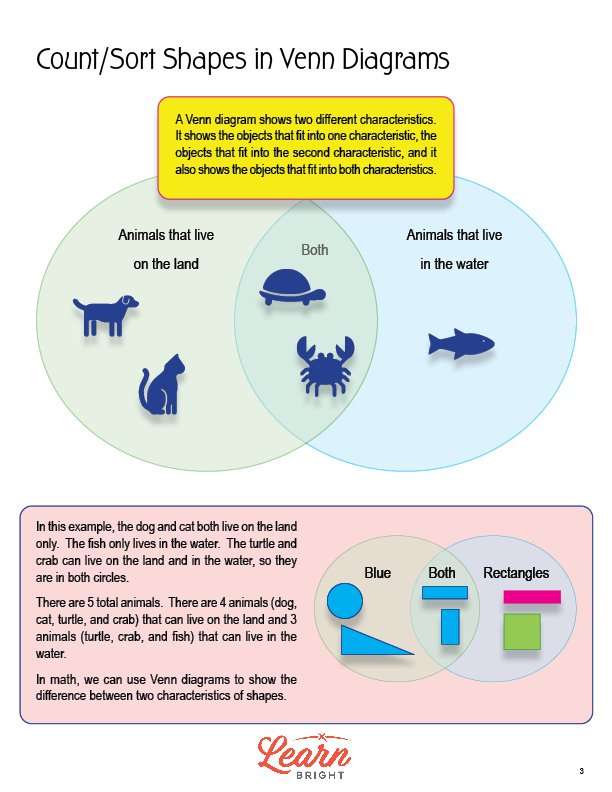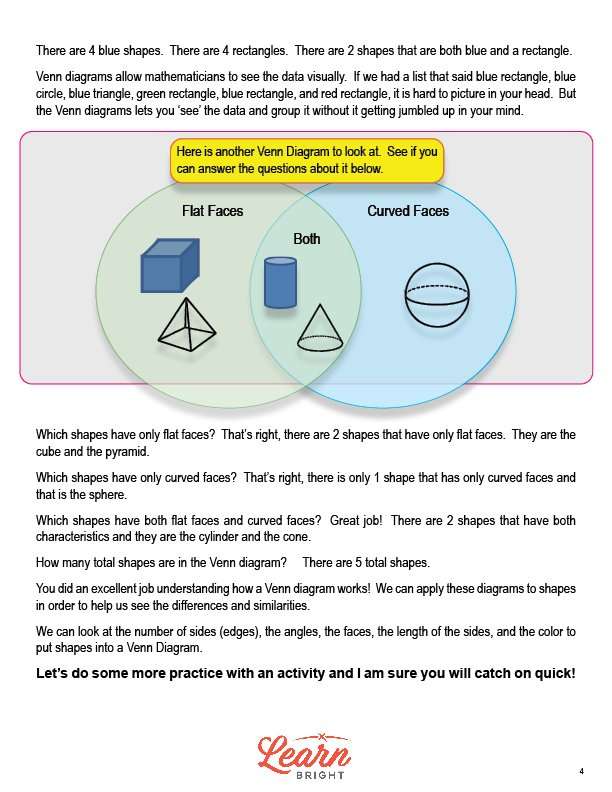Description
What our Count/Sort Shapes in Venn Diagrams lesson plan includes
Lesson Objectives and Overview: Count/Sort Shapes in Venn Diagrams lesson plan teaches students all about Venn diagrams and how to use them to sort shapes. At the end of the lesson, students will be able to count and sort shapes into Venn diagrams using various characteristics and properties of the shapes. This lesson is for students in 1st grade and 2nd grade.
Classroom Procedure
Every lesson plan provides you with a classroom procedure page that outlines a step-by-step guide to follow. You do not have to follow the guide exactly. The guide helps you organize the lesson and details when to hand out worksheets. It also lists information in the blue box that you might find useful. You will find the lesson objectives, state standards, and number of class sessions the lesson should take to complete in this area. In addition, it describes the supplies you will need as well as what and how you need to prepare beforehand.
Options for Lesson
Included with this lesson is an “Options for Lesson” section that lists a number of suggestions for activities to add to the lesson or substitutions for the ones already in the lesson. One optional addition to this lesson is to have your students use other characteristics for Venn diagrams such as dogs or weather. You could also have your students group themselves into a large chalked Venn diagram based on different characteristics that they have.
Teacher Notes
The teacher notes page includes a paragraph with additional guidelines and things to think about as you begin to plan your lesson. This page also includes lines that you can use to add your own notes as you’re preparing for this lesson.
COUNT/SORT SHAPES IN VENN DIAGRAMS LESSON PLAN CONTENT PAGES
Count/Sort Shapes in Venn Diagrams
The Count/Sort Shapes in Venn Diagrams lesson plan includes two content pages. Venn diagrams show two different characteristics and objects that fit in one, or both, of those characteristics.
For example, a Venn diagram might list “animals that live on land” on one side and “animals that live in the water.” Dogs and cats only live on land, so they would fall in that section of the Venn diagram. Fish would fall in the other section because they only live in the water. Turtles and crabs, which live in both, would fall in the middle section of the Venn diagram.
In math, we can use Venn diagrams to show the difference between the characteristics of shapes. You might have four blue shapes, four rectangles, and two shapes that are both blue and rectangular. Using a Venn diagram to sort things allows you to see data visually. It’s hard to visualize a whole list of shapes separately, but seeing them in a Venn digram allows you to easily group them.
COUNT/SORT SHAPES IN VENN DIAGRAMS LESSON PLAN WORKSHEETS
The Count/Sort Shapes in Venn Diagrams lesson plan includes four worksheets: an activity worksheet, a practice worksheet, a homework assignment, and a quiz. You can refer to the guide on the classroom procedure page to determine when to hand out each worksheet.
VENN DIAGRAM ACTIVITY WORKSHEET
The activity worksheet asks students to practice placing the shapes from the practice problems in the correct spots on a Venn Diagram.
SHAPES PRACTICE WORKSHEET
For the practice worksheet, students will cut out and glue shapes in the correct places in the Venn Diagrams on the worksheet.
COUNT/SORT SHAPES IN VENN DIAGRAMS HOMEWORK ASSIGNMENT
The homework assignment asks students to draw in three shapes for each section of three different Venn Diagrams.
QUIZ
This lesson also includes a quiz that you can use to test students’ understanding of the lesson material. For the quiz, students will place shapes in the correct spaces on a Venn Diagram.
Worksheet Answer Keys
This lesson plan includes answer keys for the practice worksheet and the quiz. If you choose to administer the lesson pages to your students via PDF, you will need to save a new file that omits these pages. Otherwise, you can simply print out the applicable pages and keep these as reference for yourself when grading assignments.









